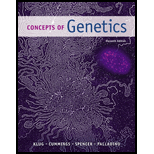
Concept explainers
a.
To determine:
The experimentally derived information that led to Holley’s proposal of the two-dimensional cloverleaf model of tRNA
Introduction:
The transfer ribonucleic acid (tRNA) is a small, single-stranded that are largely found in the cytoplasm. It is also called as soluble RNA. There are about 20 different Trna molecules are present that are involved in the decoding of the mRNA sequences into proteins. The main function of tRNA is to transfer the amino acid that is specific to the codon present in the messenger RNA sequences.
(b)
To determine:
The experimental information verifies that certain codons in mRNA specify chain termination during translation
Introduction:
The translation is the process of coding of proteins from the specific codons present in the mRNA. The ribosomes present in the outer membrane of endoplasmic reticulum carry out the translation process. This process consists of three steps namely initiation, elongation and termination. After the completion of this process, the proteins are released into the endoplasmic reticulum to form vesicles which then carried out to the cells to executes its function.
c.
To determine:
That how the idea emerges that one gene specifies one enzyme based on studies of Neurospora nutritional mutations
Introduction:
The genetic code is the sequence of nucleotides present in the mRNA that specifically codes for a particular protein. Every three adjacent nucleotides present in the mRNA constitutes the unit called as a codon. Each three-letter codon specifically codes for the particular protein. For example AUG codes for methionine. The characteristic of the codon is universal, nonoverlapping, commaless, non-ambiguity, polarity, etc..
d.
To determine:
That how the idea emerges that the proteins are the end products of genetic expression
Introduction:
The gene expression is the process of transformation of
e.
To determine:
The experimental evidence that proposes the degeneracy and wobble hypothesis of the genetic code.
Introduction:
The genetic code is the sequence of nucleotides present in the mRNA that specifically codes for a particular protein. Every three adjacent nucleotides present in the mRNA constitutes the unit called as a codon. Each three-letter codon specifically codes for the particular protein. For example AUG codes for methionine. The characteristic of the codon is universal, nonoverlapping, commaless, non-ambiguity, polarity, etc..
f.
To determine:
That how the idea emerges that the structure of a protein is intimately related to the function of that protein
Introduction:
The proteins are the
Want to see the full answer?
Check out a sample textbook solution
Chapter 14 Solutions
Concepts of Genetics (11th Edition)
 Human Anatomy & Physiology (11th Edition)BiologyISBN:9780134580999Author:Elaine N. Marieb, Katja N. HoehnPublisher:PEARSON
Human Anatomy & Physiology (11th Edition)BiologyISBN:9780134580999Author:Elaine N. Marieb, Katja N. HoehnPublisher:PEARSON Biology 2eBiologyISBN:9781947172517Author:Matthew Douglas, Jung Choi, Mary Ann ClarkPublisher:OpenStax
Biology 2eBiologyISBN:9781947172517Author:Matthew Douglas, Jung Choi, Mary Ann ClarkPublisher:OpenStax Anatomy & PhysiologyBiologyISBN:9781259398629Author:McKinley, Michael P., O'loughlin, Valerie Dean, Bidle, Theresa StouterPublisher:Mcgraw Hill Education,
Anatomy & PhysiologyBiologyISBN:9781259398629Author:McKinley, Michael P., O'loughlin, Valerie Dean, Bidle, Theresa StouterPublisher:Mcgraw Hill Education, Molecular Biology of the Cell (Sixth Edition)BiologyISBN:9780815344322Author:Bruce Alberts, Alexander D. Johnson, Julian Lewis, David Morgan, Martin Raff, Keith Roberts, Peter WalterPublisher:W. W. Norton & Company
Molecular Biology of the Cell (Sixth Edition)BiologyISBN:9780815344322Author:Bruce Alberts, Alexander D. Johnson, Julian Lewis, David Morgan, Martin Raff, Keith Roberts, Peter WalterPublisher:W. W. Norton & Company Laboratory Manual For Human Anatomy & PhysiologyBiologyISBN:9781260159363Author:Martin, Terry R., Prentice-craver, CynthiaPublisher:McGraw-Hill Publishing Co.
Laboratory Manual For Human Anatomy & PhysiologyBiologyISBN:9781260159363Author:Martin, Terry R., Prentice-craver, CynthiaPublisher:McGraw-Hill Publishing Co. Inquiry Into Life (16th Edition)BiologyISBN:9781260231700Author:Sylvia S. Mader, Michael WindelspechtPublisher:McGraw Hill Education
Inquiry Into Life (16th Edition)BiologyISBN:9781260231700Author:Sylvia S. Mader, Michael WindelspechtPublisher:McGraw Hill Education





